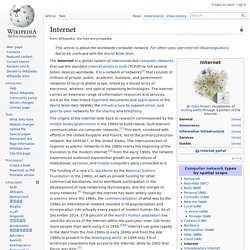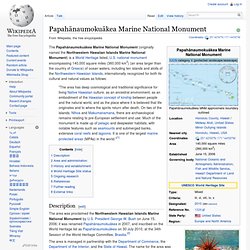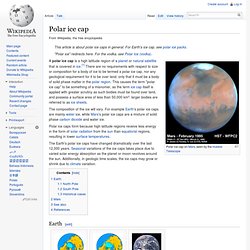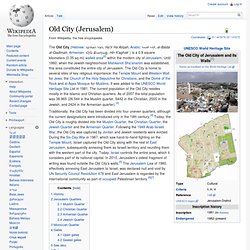

Maya civilization. Uxmal, Nunnery Quadrangle Artist's copy of Bonampak Painting, Mexico, 700 C.E.

Throne 1 of Piedras Negras The Maya is a Mesoamerican civilization, noted for Maya script, the only known fully developed writing system of the pre-Columbian Americas, as well as for its art, architecture, and mathematical and astronomical systems. Initially established during the Pre-Classic period (c. 2000 BC to AD 250), according to the Mesoamerican chronology, many Maya cities reached their highest state of development during the Classic period (c. Internet. U.S.

Army soldiers "surfing the Internet" at Forward Operating Base Yusifiyah, Iraq The Internet is a global system of interconnected computer networks that use the standard Internet protocol suite (TCP/IP) to link several billion devices worldwide. It is a network of networks[1] that consists of millions of private, public, academic, business, and government networks of local to global scope, linked by a broad array of electronic, wireless, and optical networking technologies. The Internet carries an extensive range of information resources and services, such as the inter-linked hypertext documents and applications of the World Wide Web (WWW), the infrastructure to support email, and peer-to-peer networks for file sharing and telephony.
Most traditional communications media, including telephony and television, are being reshaped or redefined by the Internet, giving birth to new services such as voice over Internet Protocol (VoIP) and Internet Protocol television (IPTV). Terminology Users. Papahānaumokuākea Marine National Monument. Description[edit] The area was proclaimed the Northwestern Hawaiian Islands Marine National Monument by U.S.

President George W. Bush on June 15, 2006; it was renamed Papahānaumokuākea in 2007, and inscribed on the World Heritage list as Papahānaumokuākea on 30 July 2010, at the 34th Session of the World Heritage Committee, Brasilia.[2] The area is managed in partnership with the Department of Commerce, the Department of the Interior, and the State of Hawaii. The name for the area was inspired by the names of the Hawaiian creator goddess Papahānaumoku and her husband Wakea. Although it is not a sanctuary, the ocean area is part of a system of 13 National Marine Sanctuaries administered by the National Oceanic and Atmospheric Administration (NOAA). Area and administration[edit] Global locator map of all sites in the United States National Marine Sanctuary system History and establishment[edit] George W.
On June 15, 2006, President George W. World Heritage Site status[edit] References[edit] Polar ice cap. A polar ice cap is a high latitude region of a planet or natural satellite that is covered in ice.[1] There are no requirements with respect to size or composition for a body of ice to be termed a polar ice cap, nor any geological requirement for it to be over land; only that it must be a body of solid phase matter in the polar region.

This causes the term "polar ice cap" to be something of a misnomer, as the term ice cap itself is applied with greater scrutiny as such bodies must be found over land, and possess a surface area of less than 50,000 km²: larger bodies are referred to as ice sheets. The composition of the ice will vary. For example Earth's polar ice caps are mainly water ice, while Mars's polar ice caps are a mixture of solid phase carbon dioxide and water ice. Polar ice caps form because high latitude regions receive less energy in the form of solar radiation from the sun than equatorial regions, resulting in lower surface temperatures.
Earth[edit] North Pole[edit] Old City (Jerusalem) The Old City (Hebrew: העיר העתיקה, Ha'Ir Ha'Atiqah, Arabic: البلدة القديمة, al-Balda al-Qadimah, Armenian: Հին Քաղաք, Hin K'aghak' ) is a 0.9 square kilometers (0.35 sq mi) walled area[2] within the modern city of Jerusalem.

Potala Palace. The Potala Palace (Tibetan: པོ་ཏ་ལ, Wylie: Po ta la, ZYPY: Bodala; simplified Chinese: 布达拉宫; traditional Chinese: 布達拉宮; pinyin: Bùdálā Gōng) in Lhasa, Tibet Autonomous Region, China, was the chief residence of the Dalai Lama until the 14th Dalai Lama fled to India during the 1959 Tibetan uprising.

It is now a museum and UNESCO World Heritage Site. The palace is named after Mount Potalaka, the mythical abode of Chenresig or Avalokitesvara.[1] Lozang Gyatso, the Great Fifth Dalai Lama, started its construction in 1645[2] after one of his spiritual advisers, Konchog Chophel (died 1646), pointed out that the site was ideal as a seat of government, situated as it is between Drepung and Sera monasteries and the old city of Lhasa.[3] It may overlay the remains of an earlier fortress, called the White or Red Palace,[4] on the site built by Songtsen Gampo in 637.[5] The building measures 400 metres east-west and 350 metres north-south, with sloping stone walls averaging 3 m. thick, and 5 m.